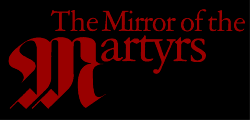Creation of the Exhibit
The Mirror of the Martyrs exhibit is based on the publication of the second edition of the Martyrs Mirror of 1685. Next to the Bible and the Anabaptist hymnbook, no book has been more influential in perpetuating and nurturing the faith of Mennonites and Amish. The second edition is particularly prized because it is illustrated with 104 etchings by the gifted Mennonite artist, Jan Luyken. The original 104 copper plates used in the printing of the 1685 edition were preserved for two centuries but were thought lost in the rubble of World War II.
Search for the Missing Plates
In 1975 thirty copper plates reappeared in South Germany. Mennonite bibliophile Amos Hoover of Denver, Pennsylvania, acquired seven of the plates, but, at the last moment 23 of the copper plates slipped into the hands of a Rhineland art collector. Efforts to purchase the remaining 23 plates failed. In May 1988 Robert Kreider of North Newton, Kansas received word of the death of the art collector and the availability again of the long-lost copper plates. After a year of negotiation the 23 copper plates were purchased by Robert Kreider on behalf of a group of friends of the Martyrs Mirror. Kreider was joined in this quest by John Oyer a fellow Mennonite historian from Goshen, Indiana.
Possession of the 300-year-old plates led to the creation of an inter-Mennonite Martyrs Mirror Trust. The Trust was shaped by three concerns:
- The plates should be kept together, neither the proud possession of one institution nor a scattering among many owners.
- Luyken's finely-tooled copper plates should be viewed as more than aging artifacts from the era of 16th century Anabaptist martyrs to be savored by only a few. Accompanied with selected martyr stories, both ancient and contemporary, they should be used to tell in fresh ways how Christians have witnessed to their faith under oppression and persecution.
- The old etched copper plates should be seen as carrying, not just a quaint, parochial story, but a universal story. Although denying their practices publicly, many governments still torture prisoners of conscience. More such prisoners languish now in lonely cells than in the 150Os. In the 2Oth century more persons have been killed for conscience sake than in any other century in history.
Designing and Building the Exhibit
In 1989 a team was engaged to design and build an exhibit. Robert Regier, former chair of the art department at Bethel College, led the team. Chuck Regier, Curator of Exhibits for Kauffman Museum on the Bethel College campus, was responsible for building the exhibit. Robert Kreider, historian, was curator. The following parameters shaped the design of the exhibit:
- The core would be the martyr stories with enlarged visuals, without additional interpretation, surrounding a central arena--the silent place of execution.
- The exhibit should convey a sense of drama as reflected in the sub-title of the Martyrs Mirror--The Bloody Theater of Nonresistant Christians.
- The exhibit should include objects in addition to the copper plates to provide visual variety. These objects or artifacts could be martyr books, tools of editing and printing, instruments of torture.
- The exhibit should be highly mobile exhibit so that the exhibit could easily go out to the people.
A modular exhibit system was designed and fabricated:
- To allow rapid assembly, disassembly and expansion or contraction to adapt to a variety of exhibit locations.
- Durable and with minimum weight.
- The primary module: an L-shaped structure combining one wide and one narrow panel.
- Self-contained lighting, a necessity for different exhibit environments.
- Custom designed van to store and safely transport all exhibit panels and crated artifacts.
Telling the Martyr Story
Since 1990 the Mirror of the Martyrs has appeared in 55 locations in 21 states and 5 Canadian provinces. See "Past Exhibit Venues."
The Martyrs Mirror story is described more fully in the book, Mirror of the Martyrs, co-authored by John S. Oyer and Robert S. Kreider, Good Books, 1990, second edition, 1999. The 96-page book highlights 27 stories from the Martyrs Mirror, all illustrated with etchings from the 1685 edition. The book also includes the biographies of editor Thieleman van Braght and artist Jan Luyken and tells of the drama of the rediscovery of the plates.
